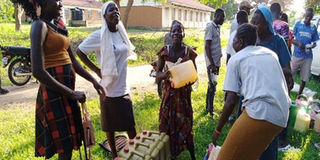Unemployment pushing West Nile youths to prison

Excited youths receive start-up kits for hairdressing from Windle International Uganda in May. Unemployment is pushing many West Nile youth to prison. PHOTO | COURTESY
Unemployment and poverty is pushing many West Nile youth into criminality, Daily Monitor has learnt.
Mr Geoffrey Elly Odongo, the deputy District Internal Security Officer (DISO) of Koboko, blamed the problem on the high level of illiteracy among the youth.
He said majority of the young people aged between 15 and 30 often drop out of school at primary and secondary levels.
“Excessive consumption of substance/drugs such as opium has caused high levels of mental diseases and high crime rate among the youths. There are also bad cultural practices where young girls are seen as a source of wealth by parents. The boys are less attended to and there is widespread laziness among men,” he told this newspaper at the weekend.
He further blamed the problem on food insecurity and unstable political situations in the neighbouring countries of South Sudan and eastern DR Congo.
Mr Odongo said the unstable political situations in the neighbouring countries characterised by lawlessness has created a vacuum which has led to illicit trade across the borders.
This has attracted the majority of youth in West Nile in search of quick benefits for daily livelihood, which unfortunately cannot be sustained because it is illegal and has had many arrested and taken to prison.
The deputy DISO also blamed the poverty situation on traditional believes in extended families.
“They encourage polygamy where young men marry many wives, produce may children and yet they are economically crippled to take care of the children,” he said.
The 2015 Youth Entrepreneurship through Enterprise and Skills Development (YES) project baseline study established that 71 percent of young people in the sub-region lived in extreme poverty.
Nonetheless, a negligible number of the youth in the study area had productive assets (for instance, only 55 percent had land and 40 percent had livestock) that could buffer any livelihood shocks.
The youth poverty status is in part fuelled by high unemployment rates in the region (estimated at 31 percent). This has resulted in many youth depending on their poor parents for daily survival as well as the rise of illicit trade in fuel, drugs and gambling.
More than 70 percent of the inmates in prisons across the region are youth, according to a 2019 SNV policy brief.
SNV is a not-for-profit international development organisation working in Agriculture, Energy as well as Water, Sanitation and Hygiene.
This alarming situation has created concerns among many key stakeholders in the region, who unfortunately lack credible information on which employment markets can trigger youth poverty reduction, the organisation said.
Mr Odongo recommended that local and refugee leaders should sensitise masses to embrace education.
Development partners operating in West Nile have also been urged to ensure they introduce livelihood projects to improve food security in the sub-region.
“They should provide family planning services so that parents can control the number of children they produce,’’ Mr Odongo said.
Windle International Uganda, an international Non-Governmental Organisation, said they have been implementing a project called skills for employment project, which is aimed at enabling young people to attain employment.
This intervention ensures equitable access to skills training for youth in refugee and host communities, Mr Andrew E. Omara, the organisation’s executive director, explained.
“We are grateful to the European Union for funding this intervention to address a critical challenge that many vulnerable youth face in accessing the local labour market. The action is providing important opportunities for youth who are acquiring productive skills to engage in meaningful activities so as to earn a living,” he said on Wednesday.
Social support
Mr Malia Manani Komure, the community development officer of South Division in Koboko Municipality, said the skilling programme has saved parents from the burden of stress brought about by idle young people.
“As local government and community development workers, we are really appreciative of the intervention and we pledge total support in doing tracer studies after equipping these youth with start-up kits,” he said.
He appealed to local leaders to join hands with civil society organisations to ensure that youth acquire marketable skills to improve their livelihoods.
Poverty levels
Since 1996, Uganda has made remarkable economic progress. Extreme poverty levels declined from 56 percent in 1996 to 19.7 percent in 2014. Yet, regional inequality persists. The 2016 Uganda Poverty Assessment Report indicated that northern Uganda, where West Nile sub-region is located, is the second poorest region after Karamoja. (World Bank, 2016).




